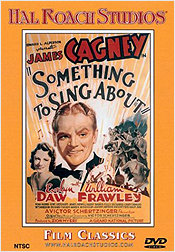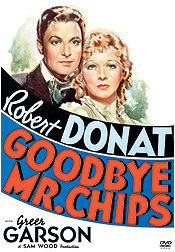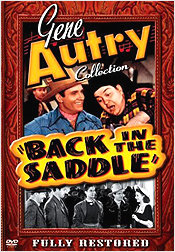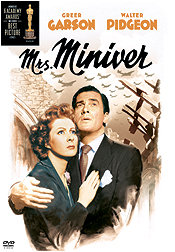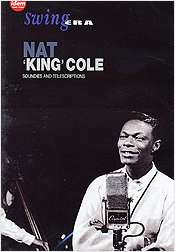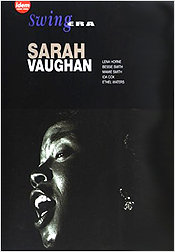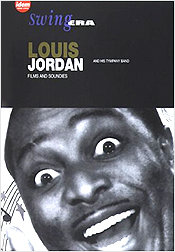 |
Site created 12/15/97.

page created: 3/3/04
 Barrie Maxwell - Main Page |
||
| Classic
Reviews Round-Up #1 - February 2004 To tide things over until my next installment of the Classic Coming Attractions column, I've got a nicely varied collection of 21 reviews for you - mostly classic movies, but also including some television both vintage and recent, and three discs of music from the Swing Era. The reviews are presented chronologically by year of the material's original release for the most part: Something to Sing About, Goodbye Mr. Chips, Back in the Saddle, Under Fiesta Stars, Mrs. Miniver, Nat King Cole, Sarah Vaughan and Friends, Louis Jordan, 1950s TV's Greatest Westerns, Diary of a Country Priest, The Prisoner, Peyton Place, The Best of Mr. Ed: Volume One, Pressure Point, For Love of Ivy, The Wilby Conspiracy, The Sidney Poitier Collection, This Property Is Condemned, Planet of the Apes, The Great Gatsby, and Frasier: Season Two. The intent is to make the Classic Review Round-ups a regular occurrence between the appearances of the classics column. Something to Sing About (1937) (released on DVD by Image on December 16th, 2003) There are a handful of James Cagney's films that are now in the public domain and this is one of them. Originally produced by Poverty Row studio Grand National and released in 1937, the film came about because of Cagney's continual run-ins with Warner Bros. over the terms of his contract and the quality of films he was being offered by the studio. In early 1936, he won a court ruling that essentially made him a free agent and he took an offer from Grand National that gave him $100,000 a picture and 10% of the earnings. He made two films for Grand National - Great Guy and Something to Sing About - but the company had difficulties with distribution, and eventually Cagney returned to Warners under a contract featuring considerably more favourable conditions than his previous one. The two Grand National pictures were pleasant outings but certainly no great improvement over some of the programmers that Cagney had been forced to make at Warners. |
||
| Aside
from the dancing, Something to Sing About
also provided a fair amount of humour. Much arose from the script's
satiric view of Hollywood, particularly its presentation of studio
boss B.O. Regan (sometimes believed to be a thinly-disguised Jack
Warner). Anyone familiar with Gene Lockhart's work can appreciate
how comically sleazy he was able to make Regan appear. William
Frawley offers an amusing characterization of studio publicist Hank
Meyers. Cagney gets into the act too with an amusing scene in which
he demonstrates various comedic facial reactions such as various
combinations of double and triple takes and slow burns. All this is
packed into a brisk 87 minutes that doesn't pretend to be anything
more than just good straight-forward entertainment. With Jimmy
Cagney pushing it along, you can't really go wrong. There have been several public domain releases of this film, but Image's DVD release (on behalf of Hal Roach Studios and advertised as being mastered from the original 35mm nitrate camera negative)) is about as good looking as it gets. I'd rate it about on a par with the previously best incarnation - Roan Group's release - although there are differences. The source material looks to be identical on the two of them but Roan's transfer is darker looking. The Image release, being lighter, offers more shadow detail but lacks the consistently deep blacks that one would prefer. Otherwise, the transfer is quite workable. There are plenty of speckles and scratches, but clarity is not an issue. Edge effects are minimal. The mono sound track has some noticeable hiss, but dialogue is clear and the musical numbers come off distortion free. The disc offers a curious theatrical trailer that ignores Cagney and instead focuses on Evelyn Daw, a new singing discovery of director Schertzinger that the film also highlights. Recommended. Goodbye, Mr. Chips (1939) (released on DVD by Warner Bros. on February 3rd, 2004) In Goodbye, Mr. Chips, we learn about Mr. Chipping who joins the staff at Brookfield School and soon becomes an unpopular teacher due to his stiff, humourless ways. While hiking in Europe with a colleague during a school break, he meets and falls in love with Katherine - an event that changes his life. His new wife charms all who come in contact with her at Brookfield and her ease in dealing with people begins to rub off on Chipping who soon begins to win over the students himself. Affectionately dubbed "Mr. Chips", he is soon one of the school's most popular personages and although Katherine dies unexpectedly, he eventually settles into a role as Brookfield's unofficial goodwill ambassador and inspirational leader. |
||
| As
with most Hollywood British films, the portrait presented of British
life, here the British public school, is an idealized one. The film
touches on issues such as class differences and the questionable
notion that nineteenth century values will see the country through
turmoil and change, but does so in a typically benevolent,
rose-coloured glasses fashion. None of that makes much difference,
however, because the defining characteristic of the film is Robert
Donat's entertaining and moving work as Mr. Chips. It is an
exceedingly accomplished piece of acting as Donat convincingly ages
by 60 years during the course of the story. Unexpectedly, Donat won
the Best Actor Oscar for 1939, beating out Clark Gable who had been
considered a virtual shoo-in for Gone
with the Wind. Complementing Donat very nicely is Greer
Garson as Katherine, here playing in her first major role. (She
would leave for Hollywood soon thereafter for a successful decade of
work at MGM.) Also look for both Paul Henreid (here billed as Paul
von Hernreid) playing Chips's colleague with whom he goes hiking,
and John Mills as a grown-up student. Director Sam Wood does a fine
job of advancing the story through the lengthy time period it
covers, using many short vignettes and particularly imagery of the
constantly changing faces and ages of the boys as they report in
each new year. Having become accustomed to exceptional-looking classic DVDs from Warner Bros., it's unfortunate to have to report that Goodbye, Mr. Chips looks somewhat the worse for wear. Presumably the source material leaves much to be desired, thus compromising Warners' ability to give us a top-notch disc. The full frame black and white image (in accord with the original aspect ratio) is clear and bright enough, but there is occasional softness and copious background speckling, debris, and scratches that at times are distracting. The Dolby Digital mono sound is also adequate enough in terms of clarity, but background hiss is evident from time to time. A French mono track and English, French, and Spanish subtitles are provided. Disappointingly, there are no supplements whatsoever included. If you haven't got a copy of the film in your video collection, by all means get a copy of this disc, but if you already have it on VHS or laserdisc (which at least has a trailer), you may want to try a rental first to see if the DVD merits doing an upgrade. Back in the Saddle (1941) Under Fiesta Stars (1941) (released on DVD by Image on January 20th, 2004) At the risk of offending part of my audience, I must confess that of the B-western big three - Hoppy, Roy and Gene, I've always found Gene Autry's films to be the least interesting on the whole. Still entertaining mind you, but somewhat lacking when it comes to acting capability and occasionally in action value too. Gene Autry loosened up on the screen in his films made after the war, but before then, his performances were somewhat wooden in my view. The two most recent releases in Image's series of Gene Autry Collection releases (12 titles have been made available so far) - Back in the Saddle and Under Fiesta Stars - are good examples. Both films were released in 1941 by Republic and feature Smiley Burnette as Gene's sidekick. |
||
|
||
| In
Back in the Saddle, Gene must
deal with a copper mining concern that is polluting rangeland by
dumping its waste into the river providing water for the valley's
cattle herds. In Under Fiesta Stars,
Gene is summoned to operate a mine and ranch willed jointly to him
and a young city woman. When Gene and the woman clash over whether
or not to sell the mine, crooked mining contractors get in on the
act. Back in the Saddle is the
better of the two films. Its plot is the more classic and the film
ends with an excitingly-staged siege of the local jail where Gene is
holed up. The film features several good songs including Gene's
signature tune and also contains a decent supporting cast including
Edward Norris, Addison Richards, and Jacqueline Wells (later known
as Julie Bishop). Unfortunately, the bad guys are an unmemorable
lot. Under Fiesta Stars is a
very bland concoction with the main action once again found at the
end, although staged quite perfunctorily. The overall casting this
time is weaker than Back in the Saddle.
We have to put up with the usual Smiley Burnette shenanigans except
that the pain is compounded by the addition of a pint-sized Burnette
in the person of Joe Strauch Jr. who plays Burnette's little brother
nicknamed 'Tadpole'. The Autry DVDs feature transfers from restored, uncut source material courtesy of the Westerns movie channel and the Autry National Center in Los Angeles. As a result, the discs look quite good on the whole. Blacks are deep and whites clean with a good gray scale range in between. The images (full frame in accord with the original aspect ratios) are usually quite crisp with only occasional softness. There is the usual speckling and the occasional scratch, but they don't really intrude upon one's viewing of the film. Under Fiesta Stars is the weaker looking (frequent soft and contrasty passages) of the two films under consideration here. The Dolby Digital mono sound is clear with only minor background hiss and crackle. The supplements are quite good, including the original introductions done for the Nashville Network's Melody Ranch Theater which screened the Autry films in the 1980s, excerpts from the Melody Ranch Radio Show which aired in the 1940s and 1950s, poster and lobby card art, production information, and original press kit material. Recommended for Gene Autry fans, but others looking for an introduction to the Autry films would do better with earlier titles so far released in the series (such as Rovin' Tumbleweeds or Robin Hood of Texas). Mrs. Miniver (1942) (released on DVD by Warner Bros. on February 3rd, 2004) Greer Garson and Walter Pidgeon became a much-appreciated acting team during the 1940s with a series of films for MGM. Blossoms in the Dust (1941) was their first film together with other entertaining outings including Madame Curie (1943), Mrs. Parkington (1944), and That Forsyte Woman (1949). Best known, however, was the 1942 Academy award winning Best Picture Mrs. Miniver. Directed by William Wyler, the film struck a chord with North American audiences for its memorable, though idealized and Americanized, portrait of an upper middle-class English family dealing with the stress and sacrifice of the early days of the Second World War. With one son in the Royal Air Force and her husband pressed into service rescuing English troops from the beaches of Dunkirk, Mrs. Kay Miniver has her own part to play in comforting her two other young children in the family's bomb shelter, surprising a hiding downed German flier and then taking him prisoner in her own kitchen, and surviving the nightly bombings that wreak havoc with her home and surroundings and the lives of the people she knows and loves. |
||
| The
film's ending is one of the great moving conclusions to a classic
film. The village's vicar (nicely played by the veteran Henry
Wilcoxon) delivers a short sermon in his bombed-out church to his
congregation that succinctly sums up what the sacrifice is all
about. It is deeply inspiring and never fails to bring a tear to the
eye. President Roosevelt was so moved upon seeing the film that he
arranged for the text of the sermon to be broadcast over the Voice
of America in Europe and airdropped in the form of translated copies
over German-occupied territory. Warner Bros.' DVD release provides us with a very fine full-frame transfer (in accord with the original aspect ratio) that exhibits a sharp, focused picture excelling in the resolution of its shadow detail and in the well-modulated gray scale it exhibits. There are some speckles and the odd vertical scratch, but none detract from the viewing enjoyment. Edge effects are not an issue. The Dolby Digital mono track is in good shape in terms of dialogue clarity and even manages to provide some depth to the bombing activities experienced by the Minivers while inside the air raid shelter. There is also a French mono track and English, French, and Spanish subtitles. Supplements consist of two vintage shorts (The Blabbermouth which reviles the sort of big talker who continually looks on the dark side of the war to the delight of the Axis members, and For the Common Defense, an entry in the Crime Does Not Pay series), a short clip showing Greer Garson receiving her Academy Award, a photo gallery, and the original theatrical trailer. Highly recommended. Nat 'King' Cole: Soundies and Telescriptions (1940s-1950s) Sarah Vaughan and Friends Louis Jordan: Films and Soundies (released on DVD by Idem Home Video on March 23rd, 2004) These three discs are part of a series of Swing Era DVDs that are becoming available through North American distribution courtesy of Music Video Distributors. Each disc features two to three dozen vintage performances either extracted from movies or originally available as Soundies or telescriptions. Soundies were essentially the forerunners to today's music videos. Generally produced during the 1940s, they were intended for use in self-contained, coin-operated, 16mm rear projection machines called Panorams located in nightclubs, bars, restaurants and other public places. Soundies were produced by various companies such as Minoco and RCM Productions, a company formed by James Roosevelt (the son of Franklin D. Roosevelt), songwriter Sam Coslow, and Herbert Mills, a pioneer in the development of arcade music machines. Between 1941 and 1947, more than 1800 soundies were made. Telescriptions were short filmed performances mainly produced by the Snader company in 1951-1952 for use as filler between TV programs in the early days of television. |
||
|
||
| The
Nat King Cole disc contains 27
numbers (all in black and white except the last one): Route 66,
Sweet Lorraine, Little Girl, Home, The Trouble with Me Is You,
Calypso Blues, For Sentimental Reasons, That's My Girl, Mona Lisa,
Because of Rain, Too Young, This Is My Night to Dream, Nature Boy,
You Call It Madness, Got a Penny, Benny?, Come to Baby Do, Errand
Boy for Rhythm, Is You Is or Is You Ain't My Baby, I'm a Shy Guy,
Who's Been Eating My Porridge, Frim Fram Sauce, Oh, Kickeroony, Now
He Tells Me, Breezy and the Bass, Solid Potato Salad, It's Better to
Be Yourself, and Always You - for a total running time of 72
minutes. Cole is backed variously by the likes of sidemen Oscar
Moore and Irving Ashby, bassists Johnny Miller and Joe Comfort, or
percussionist Jack "Mr. Bongo" Costanzo in these
selections from his early West Coast period. The disc is advertised
as being "digitally mastered from the original analog sources
with every effort made to minimize deficiencies in image and sound
quality". Unfortunately, Idem's efforts are less than
satisfactory. There is no evidence whatsoever of any digital cleanup
and the resulting images are riddled with scratches and debris, and
suffer from softness, poor contrast, and marked edge effects. In
short, they look like poor quality EP VHS tapes such as might be
issued by public domain companies. Admittedly, the source material
is in very, very rough shape, but true fans might be prepared to
accept that if the company was up-front about its condition rather
than blathering on about how they supposedly minimized the
deficiencies, but so obviously didn't. So, is there any reason to
consider the disc at all? Well, yes, there's still the music. It's
two-channel mono that offers a reasonable impression of fidelity to
it. If not amplified too much so that the ever-present background
hiss doesn't intrude, the results are quite pleasant. And when we're
dealing with Nat King Cole, the familiar mellowness comes through
quite clearly. Note that the disc is Region free and double sided,
with NTSC encoding on one and PAL on the other. The Sarah Vaughan disc brings together a collection of telescriptions and extracts from various movies and shorts (mostly in black and white) representing not just Sarah Vaughan but a wide variety of her contemporaries. There are 21 selections in all: Sarah Vaughan [You're Mine You!, The Nearness of You, You're Not the Kind, These Things I Offer, Perdido], Lena Horne [Boogie Woogie Dream, The Man I Love], Bessie Smith [Saint Louis Blues], Mamie Smith [Paradise in Harlem], Ida Cox [Kentucky Man Blues, Fore Day Creep], Ethel Waters [Quicksand, with Count Basie], and the International Sweethearts of Rhythm [She's Crazy with the Heat, That Man of Mine, Jump Children, Unidentified Title, How About That Jive, I Left My Man, Unidentified Title, Don't Get It Twisted, Just the Thing]. The DVD image quality is at best equivalent to that of the Nat King Cole disc, with softness, poor contrast, and marked edge effects common. The audio is similarly listenable at modest amplification. NTSC and PAL capabilities are again present. The Louis Jordan and his Tympany Band disc consists of 35 numbers, the first 25 of which are taken from his feature films Beware (1946) [You Gotta Have the Beat, How Long Must I Wait for You, Hold On, Long Legg's Lizzie, Good Morning Heartache, In the Land of the Buffalo Nickel, Got an Old Fashioned Passion for You, Don't You Worry About That Mule, Salt Pork West Virginia, Beware], Reet, Petite and Gone (1947) [Let the Good Times Roll, Texas and Pacific, Reet Petite and Gone, Wham Sam, All for the Love of Lil, The Green Grass Grows All Around, I Know What You're Putting Down, That Chick's Too Young to Fry, Ain't That Just Like a Woman, If It's Love That You Want That's Me], and Look Out Sister (1948) [Jack You're Dead, Turkey in the Straw, Roamin' Blues, Early in the Morning, Look Out Sister]. The remainder are from Soundies [Caldonia, Five Guys Named Moe, Honey Chile, G.I. Jive, If You Can't Smile and Say Yes, Fuzzy Wuzzy, Tillie, Buzz Me, Down Down Down, Jumpin' at the Jubilee]. Louis Jordan was a saxophonist and an enthusiastic singer who along with his band enjoyed a lot of success during the 1940s and early 1950s, and he became an important influence on R&B artists that came after him. There's an energy and liveliness to all these selections that just automatically starts the toes to tapping. Unfortunately, the DVD presentation is even poorer than for the other two discs. The movie source material which makes up the bulk of the disc is obviously in ragged condition and many of the numbers drawn from it are a chore to watch. The sound quality is also substandard with frequent background hiss and distortion and some annoying crackle in the left channel. It doesn't help either that there are synchronization problems particularly with some of the numbers from Beware. The Soundies material is in a little better shape and the results for them are comparable to the other two discs. NTSC and PAL capabilities are again present. |
||
On to Part Two
Barrie Maxwell - Main Page
 |
| Site
designed for 1024 x 768 resolution, using 16M colors and .gif 89a
animation. © 1997-2015 The Digital Bits, Inc., All Rights Reserved. billhunt@thedigitalbits.com |
